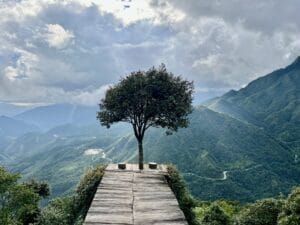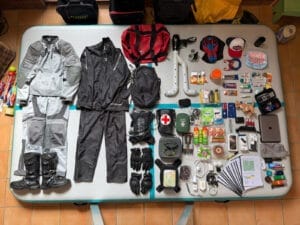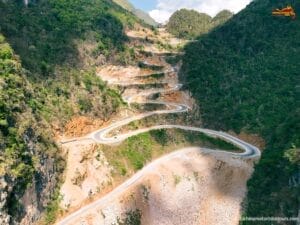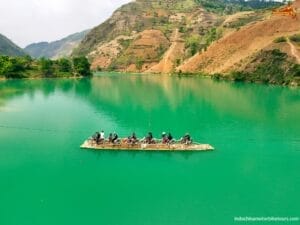Level up with every ride | Vietnam dirtbike tours 2026 The road doesn’t age you — it upgrades you. E
1. Overview of Vietnam Motorbike Tour to Sapa, Ha Giang
Vietnam is a nation that moves on two wheels. A 200,000-kilometer road network connects cities with farming villages, beach resorts to mountain escapes and dense jungles to a jagged coastline. Over 37 million scooters snake their way from the Mekong Delta in the south to the snow-dusted peaks on the Chinese border. It’s the favored mode of transport for the 90 million people that call Vietnam home, and tourists are catching on.
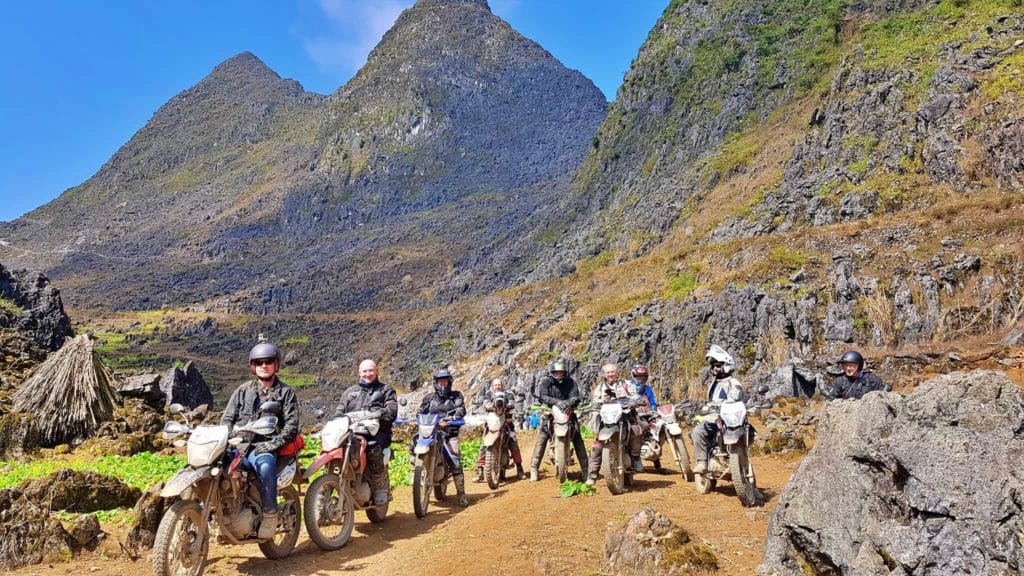
The country sees almost 18 million visitors every year, and recently a new type of traveler has started arriving – motorcyclists. And undoubtedly riding motorbikes is much inspiring foreign travelers when they come to visit this beautiful country. A popular travel route connecting Hanoi to Ho Chi Minh City has developed, with riders seeking history and culture to accompany adventure.
However, with adventure riders who wanna seek more adventurous feelings with muddy roads, tough rides over steep passes, deep valleys and on curvy buffalo trails, Northern Vietnam is really a fabulous destination to challenge themselves. Open your heart & Free your mind to engage our multiple Vietnam motorcycle tour to replenish your soul.
For many riders, northern Vietnam represents some of the best motorbiking opportunities anywhere in the world. The north offers the most majestic scenery on the grandest scale in Vietnam: the mountains are higher and the passes are loftier than anywhere else in the country. Riding can be slow (and sometimes treacherous due to landslides, floods, mud, and rough road conditions), but the scenery is sublime, the roads are extraordinarily ambitious, and the history and culture is fascinating.
I receive emails from seasoned motorbikers, who’ve spent decades riding around the world, informing me that, with the possible exception of northern India, the north of Vietnam is the best riding they’ve ever experienced. In this article, I will try to collect all experiences that i’ve grabbed for almost 15 years to show out the reason why people must do such an Ultimate Vietnam Motorcycle Tour to Mu Cang Chai, Sapa & Ha Giang together at least once in your life even if you start the trip from either east to west or west to east across the north of the country, it’s still your lifetime journey in all your ways.
Spectacularly, this 8-day Vietnam Dirt Bike Tour to Mu Cang Chai, Sapa, Ha Giang, Xin Man, Hoang Su Phi, Meo Vac, Dong Van & Ba Be Lake is too good and too enough for any adventure riders to conquer curvy passes, scenic roads of the whole Northern Vietnam to experience the most breathtaking landscapes of mountains, jungles, waterfalls & lakes even to remote villages to learn more about the real life, culture, traditions of ethnic minorities and there are still more and more other beautiful charms awaiting your explorations.
2. What highlights to uncover?
Riding to discover magnificent destinations in the North of Vietnam with stopovers at Ta Xua Peak in Phu Yen – Son La, Tu Le & Mu Cang Chai in Yen Bai, Sapa in Lao Cai, Hoang Su Phi – Xin Man in Ha Giang, Dong Van – Meo Vac – Yen Minh, Bao Lac in Cao Bang, Ba Be lake in Bac Kan …
- Experiencing & Challenging your riding skills on different terrains with the winding roads, spiral passes, sharp curves …
- Visiting lots of breathtaking natural sceneries of the Northeast of Vietnam with high mountains, jungle, deep valleys …
- Exploring unspoiled places & unknown remote villages to learn more about the local cultures, traditions and habits
- Touching local cultures, communicating with the hill tribes living on remote areas
- Tasting a variety of great local foods / specialities in the places where you will travel by
- Enjoying the cozy homestay ambiences at villages to see how welcoming the hosts would be
- Throwing yourself into the wild nature with rides on dirt tracks, narrow single tracks
- Cheering up together by the end of the day with cold beer
- Participating some unexpected charity programs at remote villages/schools
* Ta Xua Peak:
Ta Xua is a mountain range in the Bac Yen district in Son La province, northern Vietnam, 240 km from Hanoi. This mountain range forms a natural border between the two provinces of Son La and Yen Bai.
At the highest point of 2865 meters, the Ta Xua peak is the tenth highest peak in Vietnam. The three most important peaks form a line that looks like the back of a dinosaur. It is a real off the beaten track destination. Few or no foreign tourists come here. This is partly because it is so remote. The nearest place is the non-touristy Moc Chau, 85 kilometers away.
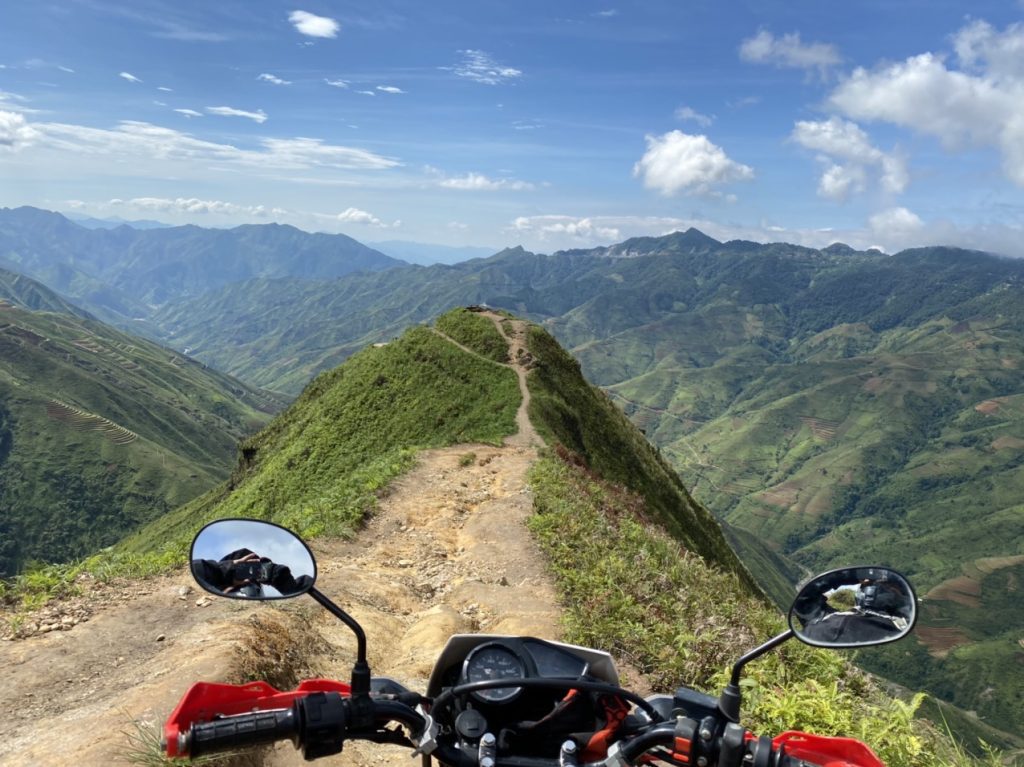
Trekking / Riding on the Ta Xua – Dinosaur’s Backbone is undoubtedly a challenge, but thanks to new roads it has become a lot easier. There are now new trails that run fairly close to one of the mountain peaks. Ta Xua is known for its phenomenon around the mountains: the formation of thick and shadowy Opacus clouds, making it look like you’re in heaven.
Getting up on a cold morning in Ta Xua is great when the sun comes up with a huge sea of fluffy clouds right in front of your eyes. All around the mountains you will see a floating ocean of clouds. After about half an hour of climbing in the cold of the mountainous area, you arrive for what you came for.
* Mu Cang Chai terrace in Yen Bai:
About 300km from Hanoi, Mu Cang Chai is a small mountainous town of Yen Bai province, located at the foot of the Hoang Lien Son Mountain. Newly discovered by travelers thanks to its scenic beauty, this is a place for you to not only admire the stunning rice terraced fields and majestic mountain landscapes but also experience the authentic life of ethnic minorities – a simple but very heartwarming life.
The best season that makes Mu Cang Chai more and more attractive to travelers is the golden rice season. It comes from September to the middle of October. The weather at this time is very please and comfortable for wandering local villages and mountain sightseeing.
Besides, the pouring season from May to June is another ideal period of time to visit Mu Cang Chai. This is summertime when you can see the rainwater flowing down from the top of the mountain into the rice fields. Under the sunshine, the terraced fields sparkle and become really eye-catching.
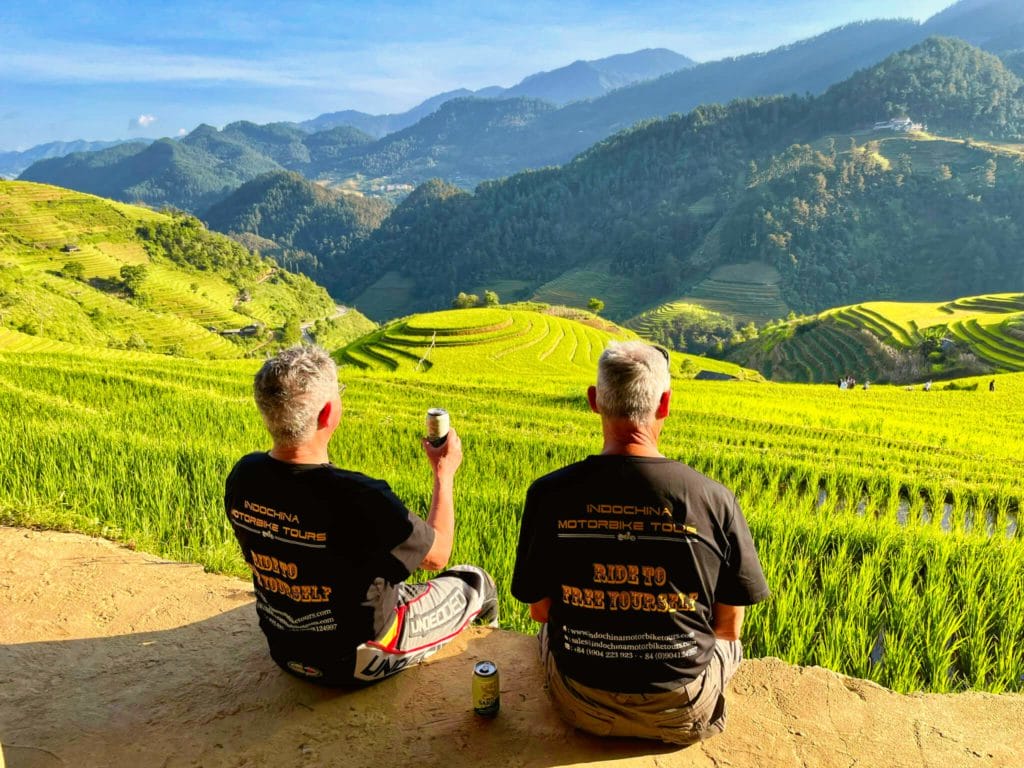
“Must-see” in Mu Cang Chai
Mu Cang Chai’s charming beauty is displayed through terraced rice fields and the tranquility of the local villages. You can witness that scenery via many places on the way and inside the small town.
Tu Le Valley
Lying on the way from Nghia Lo to Mu Cang Chai, Tu Le valley is surrounded by mountain and rice fields, giving you the best view of the nature. You can also visit Tien Nu cave nearby, get around Hmong villages to meet the friendly local people and learn about their rice-planting activities.
Khau Pha Pass
Conquering Khau Pha pass is one of the most exciting activities you should not miss when you travel to Mu Cang Chai.
Go through one winding road to another, stop on the street vendor to admire the rustic jungle and giant rice fields and feel the fresh air! However, this is the adventurous and dangerous stretch of road on rainy or cloudy days, so it’s best to weigh in the weather before starting your visit.
La Pan Tan Village
Having up to 700ha terraced rice fields with all the most beautiful terraced rice fields in Mu Cang Chai, La Pan Tan village was recognized as National Monument at the end of 2007. Here is also a suitable place for you to choose the accommodation and visit the famous “mam xoi” terraced rice field.
* Sapa
Established as a hill station by the French colonialists in 1922, Sapa today is the tourism centre of the northwest.
Sapa is oriented to make the most of the spectacular views emerging on clear days; it overlooks a plunging valley, with mountains towering above on all sides. Views are often subdued by thick mist rolling across the peaks, but even when it’s cloudy, local hill-tribe people fill the town with color.
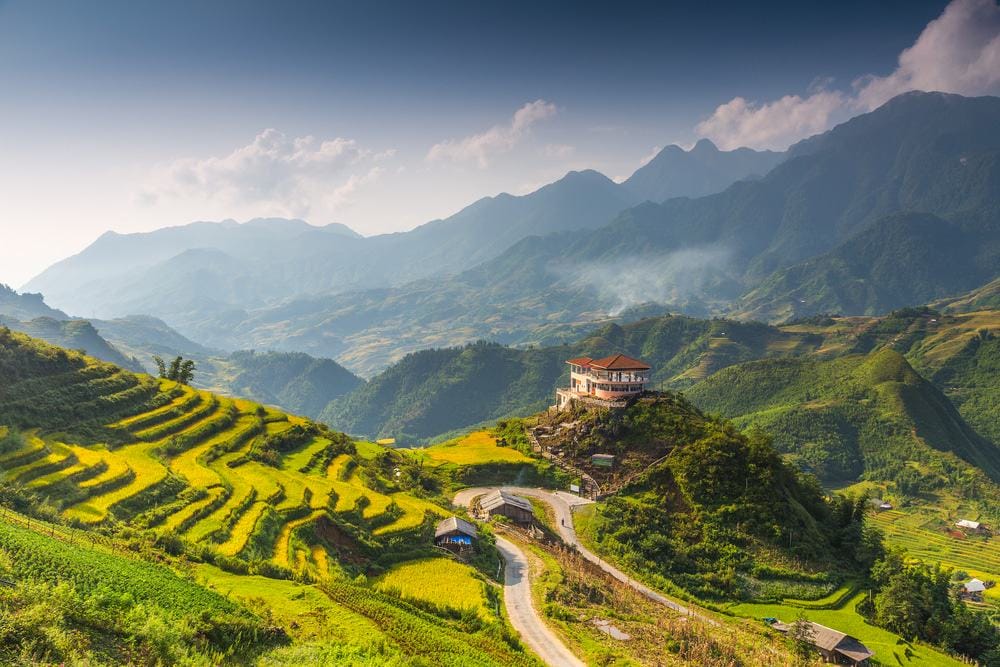
Locally known as the “town of clouds”, Sapa is a charming treasure trove of Northwest Vietnam. At a glimpse of an eye, it effortlessly mesmerizes travelers by the beauty of iconic cascading terraced rice fields, lush valleys and emerald mountains lying side by side. Endowed by nature, it’s no wonder that Sapa has become one of the most alluring destinations in the country.
What makes Sapa even more special is the cultural richness of local ethnic minorities, boasting through the numerous customs and beliefs. Set amidst the idyllic rugged valleys are the tiny hill tribe villages, home to Hmong, Dzao, and Tay groups, who have been settling down here for hundreds of years while still being able to preserve their cultures and traditions. Enjoying local life with colorful ethnic costumes, typical dances, and songs performed by people of ethnic groups would be a memorable experience lingering in your mind during and long after your trip.
Best time to visit
At an altitude of 1.560 meters above sea level, Sapa features a sub-temperate climate all around the year. The town has 4 distinctive seasons with an average temperature of 15.4°C.
The ideal occasion to discover this mountainous hub is spring lasting from March to May when the wildflowers bloom at full brightness. Spring is also the time hill tribes showcase their unique culture with a dozen festivals. Coming to Sapa during April, you also have a rare chance to experience 4 different seasons of Vietnam within one day.
From September to November, when the scorching hot summer has gone away, Sapa turns into a little paradise for photo-hunting and trailing. The best time to take great photos of the yellow rice terraces in Sapa is September. Occasionally, thick white snow is recorded in Sapa in winter (December to February), giving adventurous travelers a rare chance to admire snow-capped mountains. It’s a one-of-a-life-time experience in a tropical climax country like Vietnam.
Major Attractions :
Fansipan Mountain
Setting on top highlight destinations in the Sapa travel guide for adventurous travelers, Fansipan Mount is not only the highest peak in all of Vietnam but also the “roof of Indochina Peninsula”. The actual trek boats breath-taking a panoramic view of majestic mountains, lush valleys, and dense forests, challenging both amateur and professional hikers.
Muong Hoa Valley
Nestle in a range of marvelous mountains, the rustic and peaceful valley is known for its romantic beauty, unspoiled nature, the cultural richness of local ethnic minority, and especially an ancient rock ground, recognized as unique heritage of the ancient Vietnamese with hundreds of carvings scattering on the meadows and the cascading terraced fields of the ethnic minority.
Bac Ha Market
About 100 km away from Sapa, Bac Ha is the biggest ethnic market in the North-Western region of Vietnam. Alluring thousands of ethnic people from the nearby hill tribes, this is a great place for indigenous people to meet and boast their traditional and colorful ethnic costumes, giving travelers an ideal opportunity to discover the rich cultural diversity of Sapa.

Sapa Love Market
Sapa Love Market is a cultural beauty and unique experience no visitor should miss out in Sapa. Every Saturday evening, the town is always bustling by the charming heart of the indigenous boys, the enchanting dances of the girls dressing colorful costumes. More than a renowned place where young ethnic people come to find their partners for marriage.
Sapa Love Market is also a great base for people to retain cultural activities, exchange goods, as well as gather with friends.
Cave of Fairies
The pristine and rustic beauty of the Cave of Fairies enchants thousands of travelers from the very first glimpse of an eye. The emerald waters of the Chay river surrounded by high cliffs turns this limestone cave into a heavenly corner on earth with charming scenery. Cave of Fairies looks like something straight out of a Grimms’ fairy tale.
The Heaven Gate
Perching on the peak of Tram Ton pass on the Hoang Lien Son mountain range is the Heaven Gate. About 18 kilometers to the north of Sapa, it boasts a great view looking over the valleys between Fansipan, the roof of Indochina Peninsula. As its name reveals, this destination brings a little feeling of heaven with a sublime scenery featuring majestic mountains and extreme abyss. Setting foot on Heaven Gate to grasp the beautiful scenery of the winding pass roads below will be an unforgettable memory for newcomers to Sapa.
Cat Cat Village
With typical wooden houses, flowing streams, elaborate brocades, and hospitable ethnic people, the enchanting Cat Cat is the most beautiful ancient village in Sapa. Being the home to the H’mong ethnic group, this little hamlet is where local inhabitants retain the cultivation of flax and cotton with a long-standing tradition of weaving beautiful brocade fabrics. Drop by the village, you can learn about the one-of-a-kind customs, and practices of Hmong through their local life, as well as get an insight into their traditional culture while enjoying the local hospitality.
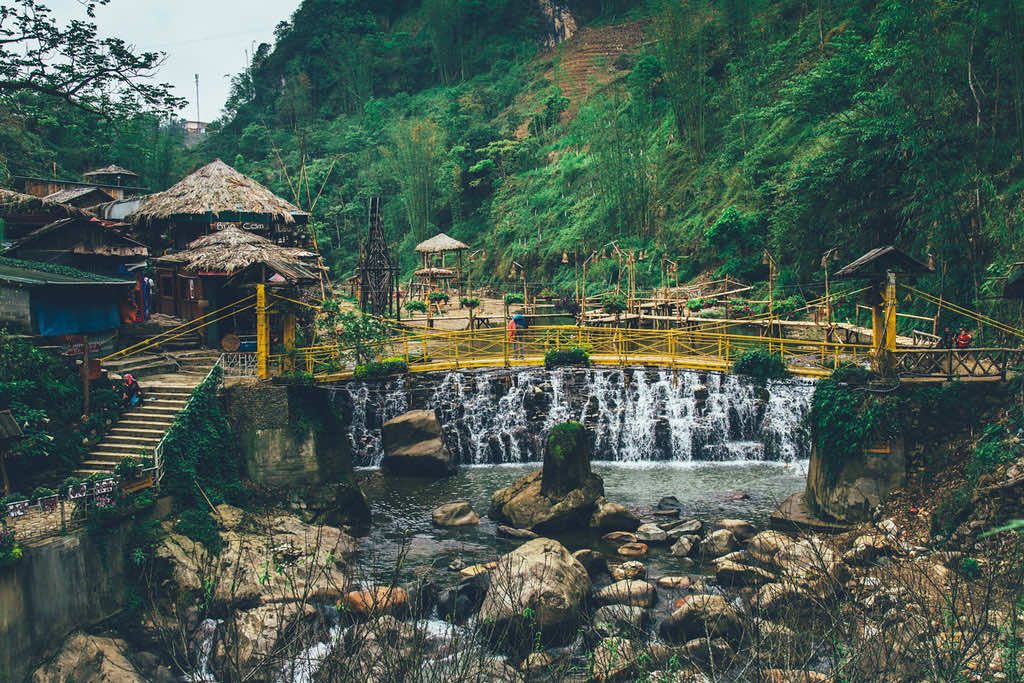
* Ha Giang:
Ha Giang is a mountainous province in the North of Vietnam in which the Vietnam-China border extends more than 274km long. The province is also the source of Lo River flowing into Vietnam, contiguous to China to the north with international border gate Thanh Thuy. Southern of Ha Giang is Tuyen Quang; eastern is Cao Bang and Lao Cai to the West. Ha Giang is about 320km to the north of Hanoi, following Highway no. 2.
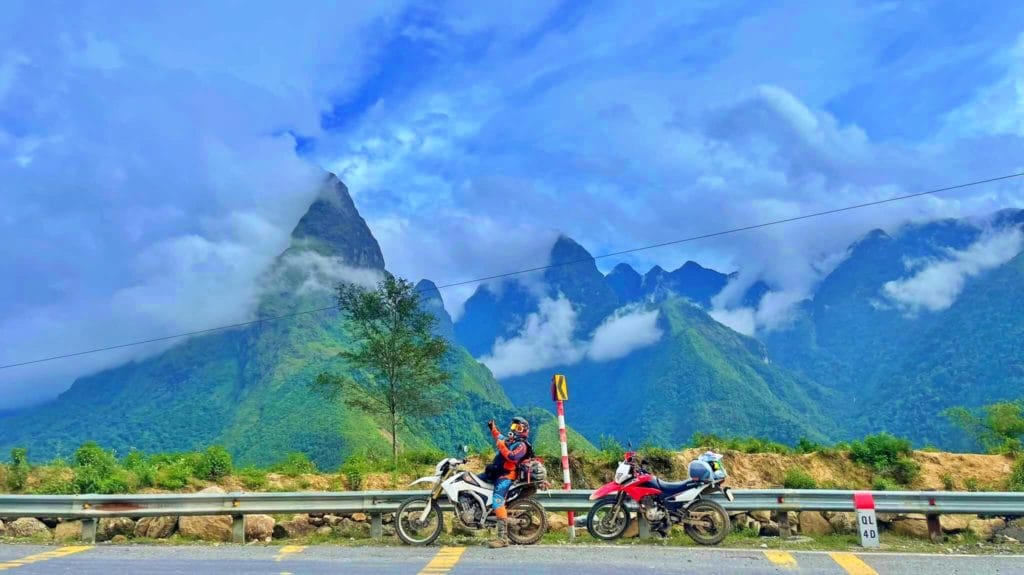
Ha Giang is quite a new city with only 120 years of history. Going through a lot of difficulties in term of unfavorable location and low level of infrastructure, Ha Giang is transforming from an economically underdeveloped province into a tourism locale that attracts a lot of visitors in the last few years.
Like any other Northern highlands of Vietnam, the climate here is cool in the summer and extremely cold in the winter which ones may see snow. The temperature of Ha Giang ranges from 5 – 28 Celcius degree, which is pretty ideal for tourism.
Ha Giang’s Tourist Attractions
Like Sapa, the most renowned attraction of Ha Giang are the many grandiose mountains. Although mountains here are not as high as Sapa’s mountains and seem not to be steep enough to challenge adventurous climbers, they stand out for extensive area of limestone with unique formation of peaky rocks.
The most famous rocky area of Ha Giang is Dong Van Rock Plateau, which is recognized by UNESCO as one of 77 geological parks in the world. Lung Cu hamlet lying inside Dong Van Rock Plateau is another indispensible destination as it marks the very northern tip of Vietnam by Lung Cu Flag Tower on Dragon Mountain.
Dong Van Karst Plateau Park:
Dong Van Karst Plateau UNESCO Global Geopark is located in the northeastern province of Ha Giang, a mountainous province located in the far north of Viet Nam. Most of its surface is limestone (about 60%). Its landscape is spectacular and unique having high mountains and deep canyons. The highest peak is Mieu Vac Mount (1971m) while Tu San is the deepest Canyon (700-800 m deep).
The Geopark has two natural conservation areas rich in fauna and flora species such as conifers, Asian black bear, Southern serow (a solitary mountain goat) and many species of bird. Moreover, the unusual and mysterious Tonkin snub-nosed monkey is one of the 25 most endangered species of primate in the world. It is only found in Ha Giang province and was believed extinct until its rediscovery in the early 1990s.

Dong Van Karst Plateau UNESCO Global Geopark is home to 17 ethnic groups which creates the unique and rich cultural heritage of this area. The socio-economic life of the Geopark should be improved to achieve the Sustainable Development Goals that Viet Nam committed. Thus, the management Board of Dong Van Karst Plateau UNESCO Global Geopark has associated with its partners in seeking support from organizations to develop sustainable tourism, conservation of heritage values and Earth science research.
H’mong King’s Palace:
The house of Vuong Family, the king of Mao ethnic, is located about 14km from the town of Dong Van in the locality of Sa Phin Commune, Dong Van, Ha Giang.
Hmong Royal Palace is the ancient villa of King Vuong Chinh Duc, the only one recognized by the Ha Giang ethnic people as king of the H’Mong ethnic people in the beginning of the 20th century. It governs Quan Ba, Yen Minh, Meo Vac and Dong Van districts.
Recognized as a national architectural and artistic relic in 1993, the mansion of Vuong family is an architectural masterpiece of the Mong ethnic people living in Dong Van karst plateau. The mansion is a must-visit place that tourists in Vietnam travel should not skip on their tour in a mountainous province of Ha Giang. Located in Sa Phin Valley, Dong Van District, Ha Giang Province, the house originally was the mansion of Vuong Chinh Duc, the head of the Vuong family – the most powerful Mong ethnic family in the region more than 100 years ago. He proclaimed himself as the King of the region, and adopted the title “Vua Meo”, meaning “King of the Meo” (former name of the Mong ethnic group) to dominate all the northern mountainous region.
During the Nguyen dynasty, King Khai Dinh in 1913 issued a royal proclaimation appointing Duc as the sole rule of the frontier region; and today visitors can see the royal proclaimation hanging in the main room of the mansion. Inheriting power from his father, Duc’s son, Vuong Chi Sinh, also commanded the region in the early decades of the 20th century before becoming a deputy to the first and second National Assembly of the Democratic Republic of Viet Nam (the forerunner to the Socialist Republic of Viet Nam). He was renamed Vuong Chi Thanh by President Ho Chi Minh. Sinh donated most of his treasure to the Vietnamese resistance government led by President Ho in the war against the French occupation (1946-1954).
This mansion is impressive not because of its gigantic size, but its magnificence and unique design. As it was created by the Chinese stone artists from Yunnan (China) and the skillful Mong builders, the place’s design is influenced by the traditional architecture of the Qing dynasty in China in the late 1890s, as well as some element from the local Mong culture. This destination is a must-see that you should not skip on your tour in Ha Giang.
The Vuong family’s Palace is just like a stone castle among the nature, protected by the high canopy of special trees in Ha Giang. The mansion itself is a masterpiece of architecture, taking 10 years of construction to finish as it’s seen nowadays.
According to Vuong family history, to build the house, Duc invited a Chinese fengshui master to choose an auspicious location for the building. The tortoise-shaped Sa Phin Valley, was believed to act as symbol of longevity and prosperity, a good omen when combined with the protective belt of eight surrounding mountains. The mansion’s structure is based on the shape of the Chinese character “wang”, which also means “wealthy”, with four horizontal and six vertical house blocks.
Located on a mountain with a tortoise’s back shape, this house was expected to bring wealth and prosperity to the owner because the turtle is one of the four sacred animals in the traditional Vietnamese legend (the four being the Dragon, Unicorn, Turtle and Phoenix). It was arranged with 4 horizontal and 6 vertical blocks divided into 2 floors and 64 rooms. The house was decorated carefully with images of sacred and respected animal such as lion, dragon, bat and phoenix to show the prosperity and wealth of the family.
Around the mansion, there is a sturdy rocks wall which is 50cm in width, with a number of guarding towers and loopholes. This wall not only protects the family against the assault of enemies from the outside, but also forms a feeling of massiveness to the inner house. Outside of the mansion is the rock road that leads to the main entrance, and the tomb of the family.
The mansion has three stilted houses. The main house faces the gate, two houses parallel and perpendicular to the main house. All stilted houses were made of wood. The main house is the place of Vuong Chinh Duc, the other houses for soldiers who server and protect the mansion. Apart from the main area, the mansion also was designed living room, pool… These items are built in accordance with the practices of the H’Mong living in highland. The wall is built around with military guards to ensure the security of the whole building. Besides, Ha Giang Provincial museum has display more of its artifacts reflect the cultural life and productive labor of the H’Mong.
* Lung Cu Flag Tower:
Lũng Cú Flag Tower is a monument in northern Vietnam. It is located in Lũng Cú commune of Dong Van district in Ha Giang province. The monument consists of a 30-metre tall (98 ft) tower on the summit of Lũng Cú Peak (over 1,400 metres (4,600 ft) above sea level). The tower is topped with a large Vietnamese flag. The monument was built to mark the northernmost point in Vietnam, although the farthest north point on the Chinese-Vietnamese border is actually located over 3.3 km (2.1 mi) farther north.
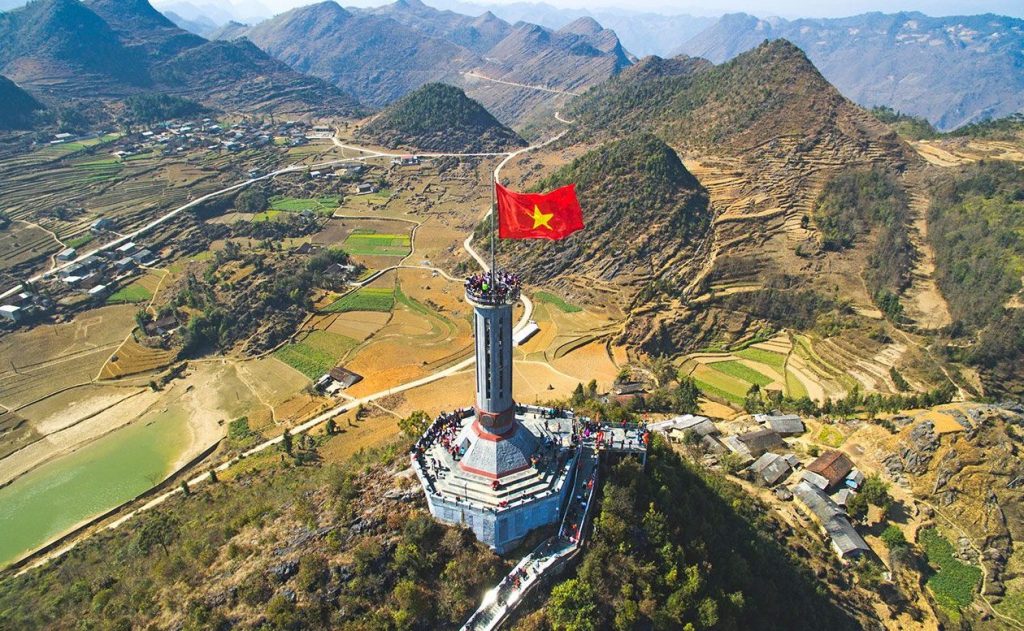
* Ma Pi Leng Pass:
The Ma Pi Leng pass is the most impressive mountain pass in Vietnam at an altitude of 1,500 meters. It is located between Dong Van and Meo Vac, two cities in the far north of Vietnam in Ha Giang province, close to the border with China. It is the most amazing mountain road in all of Vietnam.
It lies along the asphalted national road 4C with the nickname “The Happiness Road”. The road was built in the 60s by a lot of workers, mainly ethnic minorities from the area. It took 11 years to finish the whole road.
It is known as the King of Vietnamese mountain passes. There are cliffs and abysses almost everywhere along the route and enough hairpin bends to get dizzy. The road along the mountainside has a romantic, breathtaking landscape that is ideal for motorcycling. The road to the top, considered “the Great Wall of Vietnam”, feels like a scene from a fairy tale.
* Dong Van Ancient Town:
Dong Van old quarter-100 years old located in Dong Van District, Dong Van, Ha Giang. With the ancient architecture, it still keeps intact contour. Dong Van old quarter is the pride of people here. The lifestyle and daily life of ethnic people such as: Kinh, Tay, Mong, Hoa… is very impressive.
Dong Van Town is located in the middle of valley surrounded by rocks. In the morning, picture of old quarter is blended two colors: bright yellow of the sunshine and gray of ancient houses. The quarter is formed form the early 20th century, only has a few families of the H’mong, Tay and Chinese, gradually, more and more other local residents find it. Overall, old quarter has Chinese’s architecture with two-story houses of yin and yang roofs, red lantem…
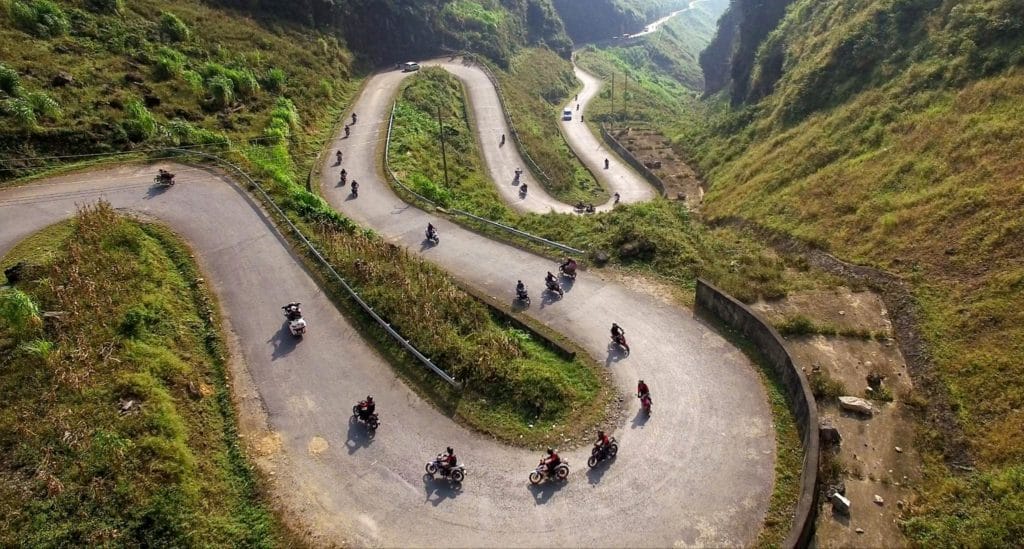
From above looking down, next to three markets arranged in U-shape with yin and yang roofs are two ancient streets that lead to the mountain. A mainly residential area of the Tay and dozens of ancient houses is concerned as the important part of Dong Van old quarter. According to documents from a workshop about Dong Van old quarter, there have about 40 ancient houses with 100 years old. Especially, there has a house nearly 200 years old of Mr. Luong Huy Ngo, built in 1860.
The common architecture here is the two-story house and yin and yang roofs. Besides, Dong Van market area has tubular ancient houses to use advantages as Ha Noi old quarter. From 2006, Dong Van district held “night in old quater” in March on 14, 15, 16 lunar calendar. All households in the old quarter hang red lanterns, display ethnic brocade, and sell traditional food. “Night in old quarter” in Dong Van karst plateau is also working for propagation to attract tourists. Tourists can learn more about culture of ethnic people through local people and soak into dance of the Lo Lo, enjoy traditional dishes such as: Thang Co, Men Men, Ta Chua, of the H’Mong and visit the area display local produce.
Dong Van old quarter is an ideal destination in the North of Vietnam, which preserves the tradition and cultural intangible values of ethnic people.
3. How does the trip look like?
To know how the trip would be carrying on, please take a look at our trip’s map at 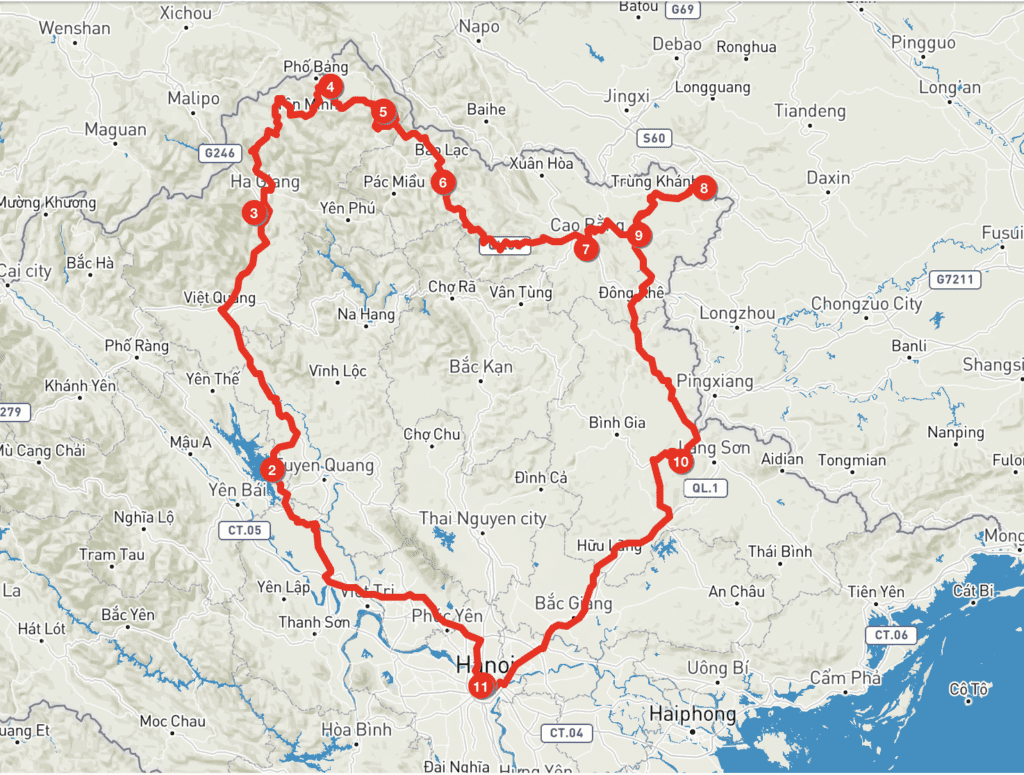
otherwise you can follow us at our youtube’s channel to see what we’re doing
3.1. What is the terrain of the trip?
Vietnam’s northern terrain is mostly mountainous or hilly, with some highland areas covered by a thick green blanket of jungle and somehow the terrains in the north of Vietnam are very diversified with mixed sealed roads, unpaved rocky roads, twisted roads, steep passes, sharp curves, single dirt tracks, buffalo trails … those terrains really become big challenges for any rider and hide themselves lots of dangers but also much inspire motorbikers to conquer. With those challenging terrains, riders are strongly requested to have intermediate riding skills to engage otherwise you’ll be trained to ride in Hanoi before starting the trip
3.2. What about the accommodation?
We’ll be using mostly standard 3-star hotels cum traditional homestay to accommodate our guests on the trip. All hotels / traditional homestay in the villages are internationally standardized with necessary modern facilities of air conditions, cable TV, hot-shower, private restrooms, soft mattresses + blankets + pillows + mosquito net … and specially no matter where you will be staying overnight on the trips, there will be always Wifi/internet connections available to keep you connected with your families as well as follow your business in 24/7
3.3. What should riders eat on the trip?
We’ll strongly commit accommodating widely local foods for many different types of customers with vegans, gluten-free, diabetes …all foods are always well selected, fresh, healthy & organic because they all are being grown by the locals inside their gardens, terraces.
We ensure that our guests will be maximized tasting as much as possible different menus/local foods at each place where you stop by to learn more about the amazing Vietnamese cuisines
4. When is the best time to do this trip?
“When is the best time to motorbike in Vietnam” is a popular question however it’s not easy to give the correct answer because Vietnam is a long country and most of the area of Vietnam is mountainous so the climate is changeable and different in each parts in the same time. In some places, you can have 4 seasons in just one day. During the rainy season but you may have a whole week without any rain in the day. It may be sunny in one side of the mountain but the other side could be cloudy/foggy or rain.
Based on geographic and climatic conditions, there are 7 different climatic regions in Vietnam: Northwest, Northeast, North Delta (Red revier delta), North Central (North Central Coast), South Central (South Central Coast), Central Highlands, and the South. These seven regions are widely accepted within the Vietnamese climatological community.
Generally, these 7 different climatic regions are grouped into 2 main types: The North (includes Northwest, Northeast, North Delta (Red River Delta), North Central (North Central Coast)) which includes all areas north of the Hải Vân Pass and the South (South Central Coast, Central Highlands and the extreme south) which includes all areas south of the Hải Vân Pass. These climatic regions are based on time of rainy season and other climatic elements such as insolation, sunshine, temperature, precipitation, and humidity. The diverse topography, wide range of latitudes (Vietnam spans over 15° of latitude), and influences from the South China Sea lead to climatic conditions varying significantly between regions.
Below is our summery for the weather in North Vietnam and South Vietnam from Hoi An to Saigon so that you can choose your suitable time for your motorcycle tours in Vietnam:
North Vietnam: Spring (from Feb to April) and Autumn (from August – October) must be the best time to tour around North Vietnam by motorbikes. November December is quite cool and dry but could be foggy, January is quite cold in mountains (around 5 degree C). Rain usually in June – July.
+ Northwest Vietnam: The Northwest region includes the provinces of Lai Châu, Sơn La, and Điện Biên. The climate is characterized by cold, dry (little drizzly rain), sunny winters in which hoarfrost is common in many years: Summers are hot and rainy, coinciding with the rainy season although there is a high frequency of hot, dry days caused by westerly winds.
Valleys are sheltered from wind, leading to a longer dry season and lower annual rainfall. The dry season usually lasts for 4–5 months. The average annual amount of sunshine hours is 1,800 to 2,000. Owing to diverse terrain and climate in this region, this leads to different types of forests being present.
+ Northeast Vietnam: The Northeast region includes the northern and northeastern provinces: Hà Giang, Phú Thọ, Cao Bang, Lạng Sơn, Bac Kan, Thái Nguyên, and Quảng Ninh… The climate is strongly influenced by the northeast monsoon. Winters are cold, cloudy (little sunshine) that is characterized by drizzle. The cold comes earlier than other provinces. Summers are hot and rainy that coincide with the rainy season.
However, unlike the northwest, dry conditions are rare due to a low frequency of westerly winds. The rainy season usually lasts from May–September although its duration can vary from 4 to 10 months. In the Hoang Lien Son mountains, winters are cold where snowfall and hoarfrost can occasionally occur. These mountains have the highest rainfall in the country. The average annual amount of sunshine hours is 1,400 to 1,700
South Vietnam: With almost sunny and hot days year-round, usually rains in the afternoon from May – November but normally quick rain or rain in the late afternoon.
Our answer: We organize motorbike tours in Vietnam in whole year-round and we can say each time of year has pros and cons. As we say, It may rain usually from June – August but it’s just like a quick shower then stop to be sunny again and the pros of this time is that you can see the most beautiful color in the mountain with full of rice terraces and blue sky everyday with rainbow sometimes.
Or Feb – April is a cool and dry time for touring Vietnam by motorbike but it could be sometimes foggy or drizzle so the view is limited on some un-lucky days.
5. What to prepare for the trip?
To get more details on this, pls check at : How to prepare a flawless Vietnam Motorcycle Tour

